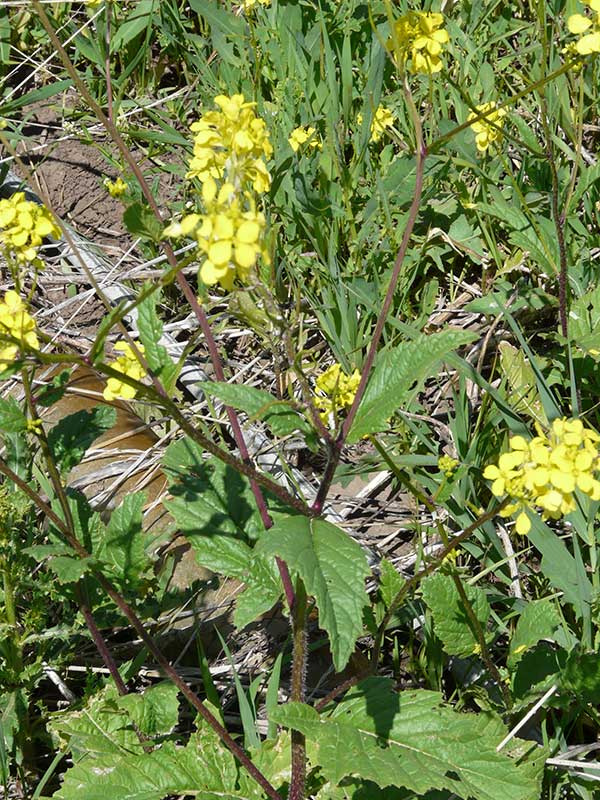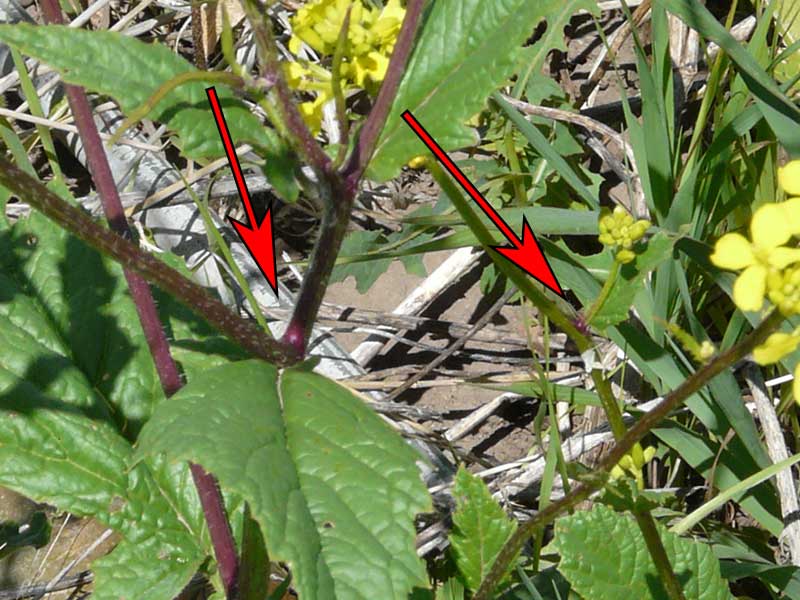Rhamphospermum arvense / Charlock
- yellow-flowered brassica; flowers larger than most mustards
- large-ish leaves with toothed margins
- erect stems; look for a reddish purple ring at stem junctions
- disturbed areas, road sides and waste places; prefers high nutrients
- 1″ siliques point out or up, but not down
Also known as: wild mustard, corn mustard, field mustard, crunchweed
Synonym: Brassica kaber, B. arvensis, Sinai’s arvensis
Charlock, a.k.a. field mustard is an annual or winter annual (one that germinates in fall then does most of its growth and reproduction the next year). It can reach up to about 30 inches. This species is not clonal, spreading only by seeds.
The yellow flowers of charlock are larger (ca. 1/2 inch across) and more showy than most species of mustard but otherwise have the expected 4 petals. They also have 6 stamens and a single, green pistil. The flowers occur in rounded clusters – racemes – at the top of the stems.
After pollination, the petals fall off and the stigma elongates into a seed pod of the silique variety. The fruits are long and thin and range from sticking straight out from the stem to strongly ascending, but not descending. They have a beak at the tip which is about half as long as the entire silique. Overall, the siliques are under 1″ long. The seeds are little bb’s – just like mustard seeds in the spice department at the grocery stores. They can remain viable in the soil for up to 60 years and germinate unexpectedly.
Charlock stems are erect, branched and sometimes striped, with white, coarse, spreading hairs especially near the base. These distinguish the species from other mustards. There is also often a reddish purple ring or patch at the branch point of stems (see gallery photos). This is also considered distinctive for the species and may show up in phone photos even if they were not the target of the pic.
The basal leaves have petioles but those higher on the stem may be sessile or even clasping. The stem leaves develop alternately. Basal leaves may be as much as 6″ long and generally oval shaped, but typically broader at the tip than the base. The stem leaves are smaller than the basal leaves. Basal leaves are coarsely toothed and diamond shaped. The upper leaves are narrower, almost like a lance point, and have coarsely toothed, slightly wavy margins. They can be as wide as they are long. Take all this with a grain of salt because there is a great deal of possible variation in the leaf shapes.
Charlock grows in pastures, fields, roadsides, and waste places, but especially where cultivation or disturbance are the feature. It is one of the most widespread and abundant weeds of cultivated grain fields in North America, but fortunately, doesn’t significantly invade high quality natural areas.
| Color | |
|---|---|
| Family | |
| Blossom size | |
| Inflorescence size | |
| Inflorescence type | |
| When? | |
| Where? |


